Management Accounting Report: Scope, Cost Analysis, and Reports
VerifiedAdded on 2023/01/19
|13
|3130
|97
Report
AI Summary
This report provides a comprehensive overview of management accounting (MA), detailing its definition and the crucial role of the management accountant within an enterprise. It explores the scope of MA, illustrating its significance across various business functions, including planning, organizing, controlling, and decision-making. The report contrasts MA with financial accounting, highlighting key differences in their objectives, information provided, and reporting formats. It then examines different types of cost reports, such as job costing, batch costing, and inventory costing, outlining their benefits and applications. Additionally, it covers activity-based costing and its advantages. The report concludes with an analysis of break-even analysis and profit evaluation within a firm, providing a complete understanding of MA principles and practices.
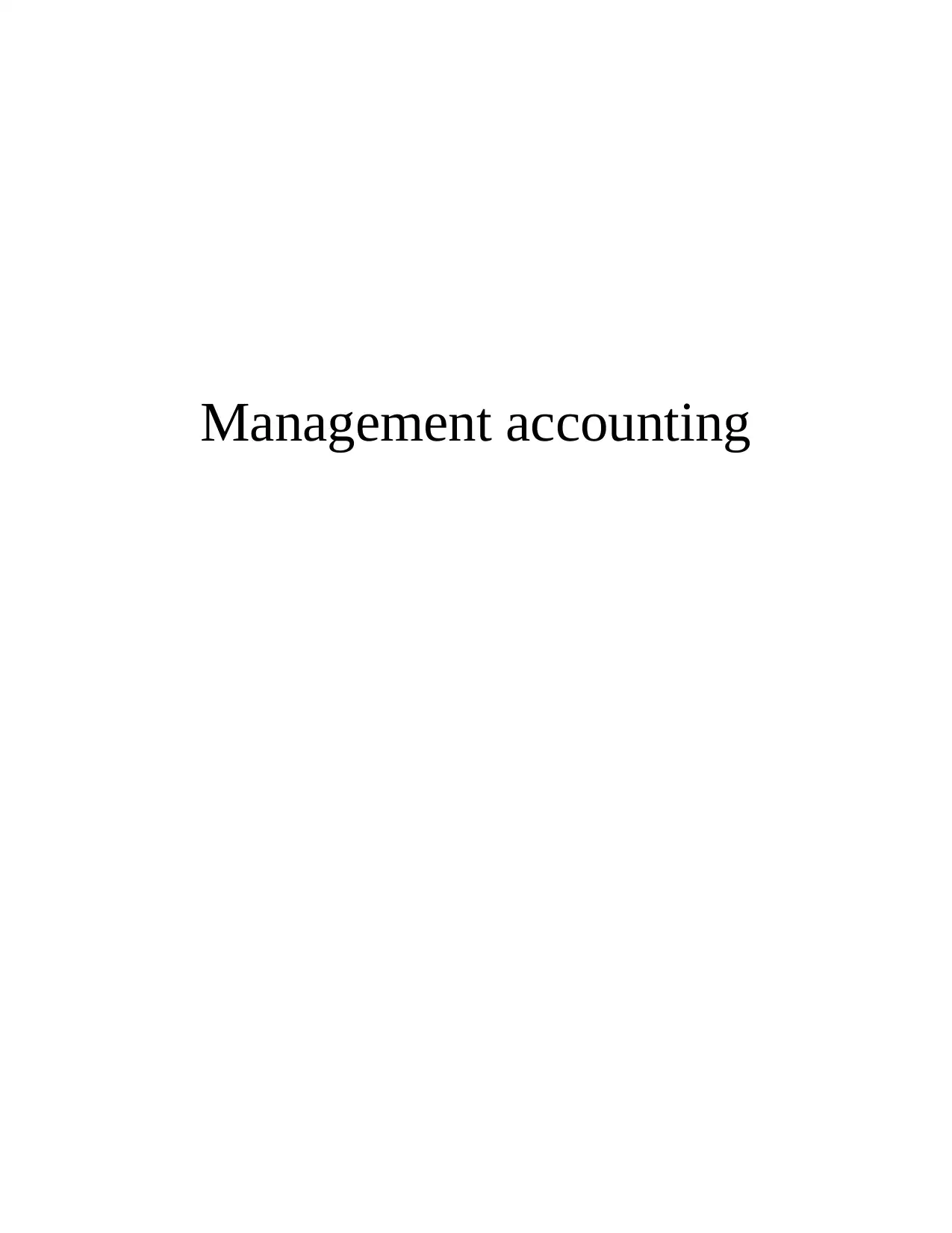
Management accounting
Paraphrase This Document
Need a fresh take? Get an instant paraphrase of this document with our AI Paraphraser
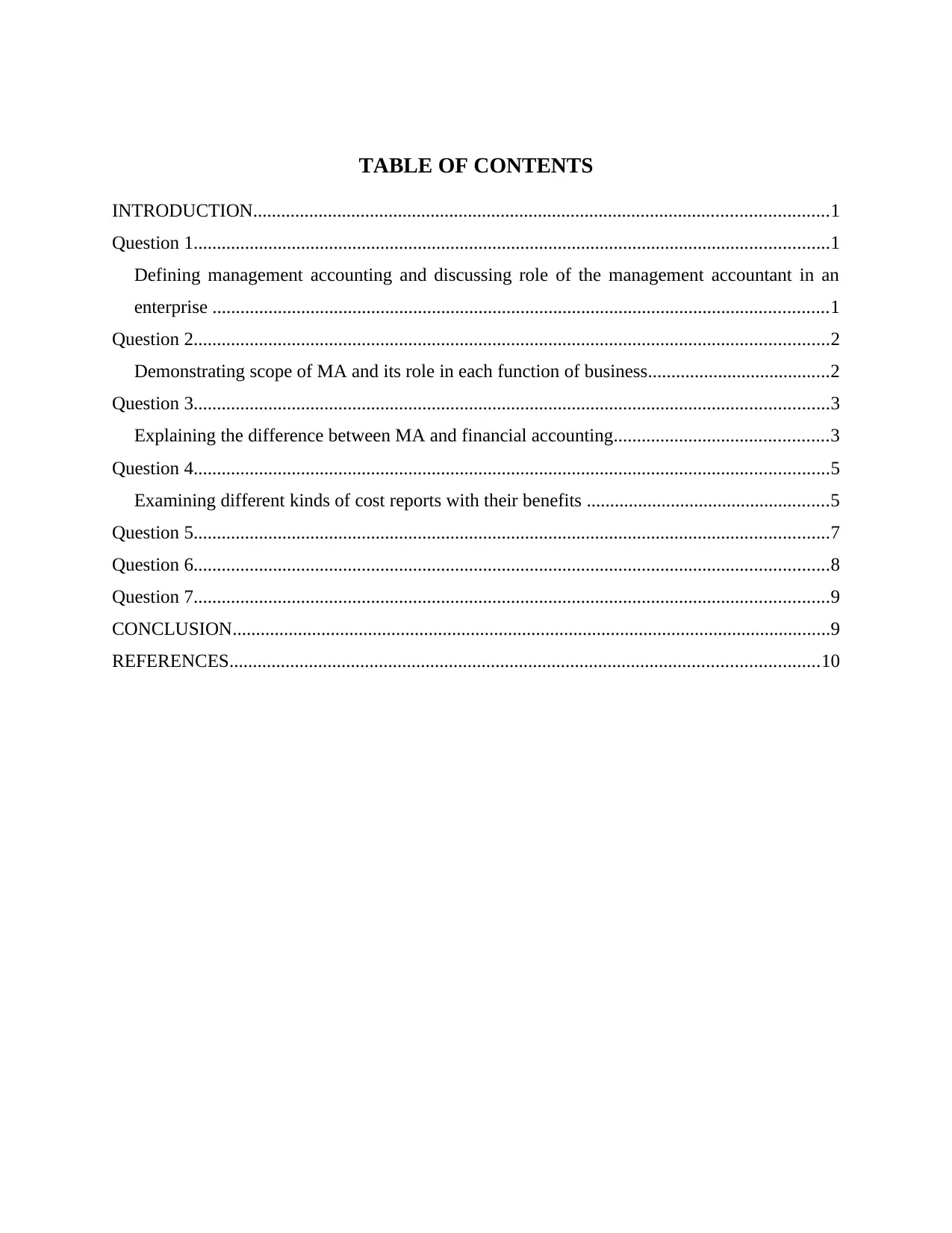
TABLE OF CONTENTS
INTRODUCTION...........................................................................................................................1
Question 1........................................................................................................................................1
Defining management accounting and discussing role of the management accountant in an
enterprise ....................................................................................................................................1
Question 2........................................................................................................................................2
Demonstrating scope of MA and its role in each function of business.......................................2
Question 3........................................................................................................................................3
Explaining the difference between MA and financial accounting..............................................3
Question 4........................................................................................................................................5
Examining different kinds of cost reports with their benefits ....................................................5
Question 5........................................................................................................................................7
Question 6........................................................................................................................................8
Question 7........................................................................................................................................9
CONCLUSION................................................................................................................................9
REFERENCES..............................................................................................................................10
INTRODUCTION...........................................................................................................................1
Question 1........................................................................................................................................1
Defining management accounting and discussing role of the management accountant in an
enterprise ....................................................................................................................................1
Question 2........................................................................................................................................2
Demonstrating scope of MA and its role in each function of business.......................................2
Question 3........................................................................................................................................3
Explaining the difference between MA and financial accounting..............................................3
Question 4........................................................................................................................................5
Examining different kinds of cost reports with their benefits ....................................................5
Question 5........................................................................................................................................7
Question 6........................................................................................................................................8
Question 7........................................................................................................................................9
CONCLUSION................................................................................................................................9
REFERENCES..............................................................................................................................10
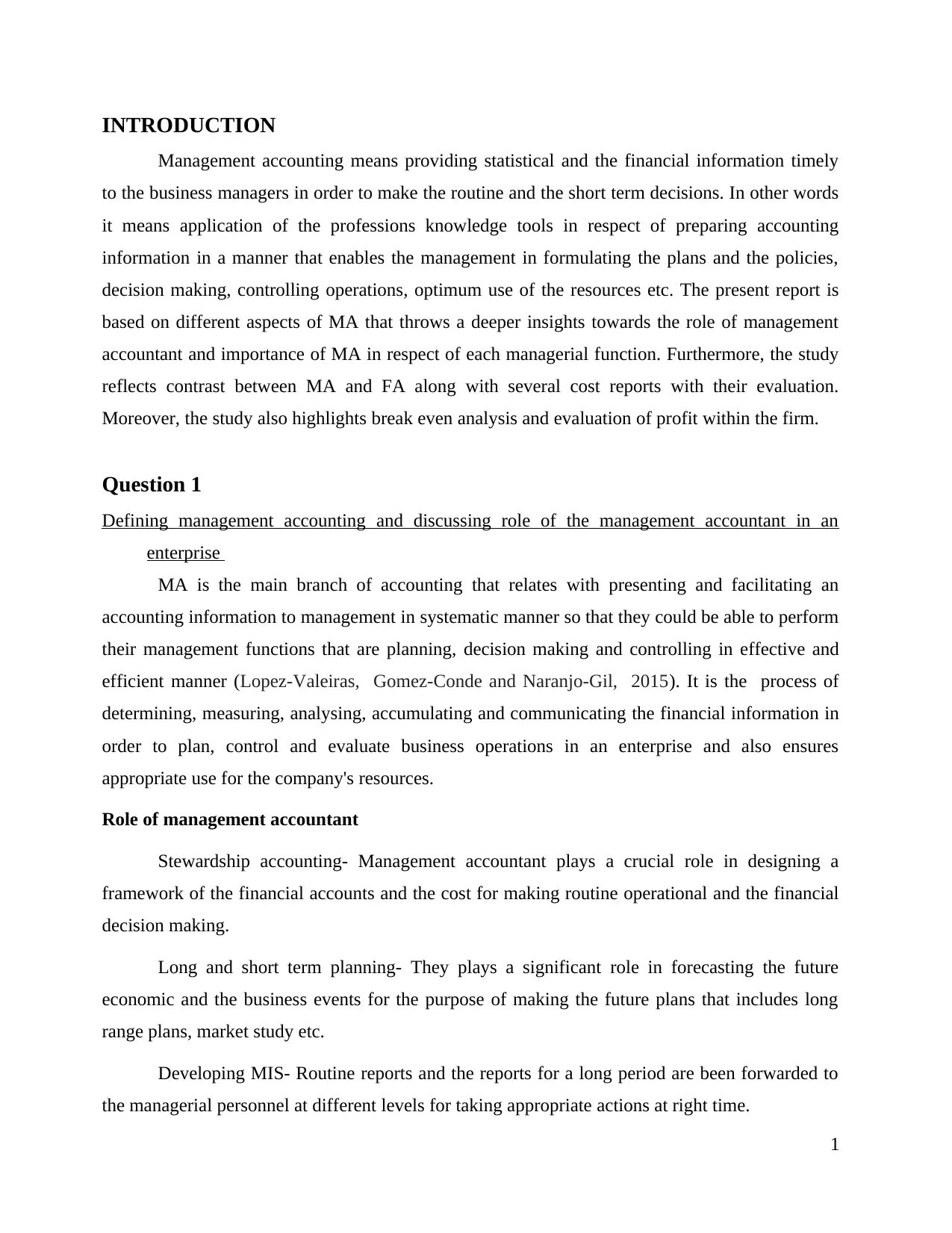
INTRODUCTION
Management accounting means providing statistical and the financial information timely
to the business managers in order to make the routine and the short term decisions. In other words
it means application of the professions knowledge tools in respect of preparing accounting
information in a manner that enables the management in formulating the plans and the policies,
decision making, controlling operations, optimum use of the resources etc. The present report is
based on different aspects of MA that throws a deeper insights towards the role of management
accountant and importance of MA in respect of each managerial function. Furthermore, the study
reflects contrast between MA and FA along with several cost reports with their evaluation.
Moreover, the study also highlights break even analysis and evaluation of profit within the firm.
Question 1
Defining management accounting and discussing role of the management accountant in an
enterprise
MA is the main branch of accounting that relates with presenting and facilitating an
accounting information to management in systematic manner so that they could be able to perform
their management functions that are planning, decision making and controlling in effective and
efficient manner (Lopez-Valeiras, Gomez-Conde and Naranjo-Gil, 2015). It is the process of
determining, measuring, analysing, accumulating and communicating the financial information in
order to plan, control and evaluate business operations in an enterprise and also ensures
appropriate use for the company's resources.
Role of management accountant
Stewardship accounting- Management accountant plays a crucial role in designing a
framework of the financial accounts and the cost for making routine operational and the financial
decision making.
Long and short term planning- They plays a significant role in forecasting the future
economic and the business events for the purpose of making the future plans that includes long
range plans, market study etc.
Developing MIS- Routine reports and the reports for a long period are been forwarded to
the managerial personnel at different levels for taking appropriate actions at right time.
1
Management accounting means providing statistical and the financial information timely
to the business managers in order to make the routine and the short term decisions. In other words
it means application of the professions knowledge tools in respect of preparing accounting
information in a manner that enables the management in formulating the plans and the policies,
decision making, controlling operations, optimum use of the resources etc. The present report is
based on different aspects of MA that throws a deeper insights towards the role of management
accountant and importance of MA in respect of each managerial function. Furthermore, the study
reflects contrast between MA and FA along with several cost reports with their evaluation.
Moreover, the study also highlights break even analysis and evaluation of profit within the firm.
Question 1
Defining management accounting and discussing role of the management accountant in an
enterprise
MA is the main branch of accounting that relates with presenting and facilitating an
accounting information to management in systematic manner so that they could be able to perform
their management functions that are planning, decision making and controlling in effective and
efficient manner (Lopez-Valeiras, Gomez-Conde and Naranjo-Gil, 2015). It is the process of
determining, measuring, analysing, accumulating and communicating the financial information in
order to plan, control and evaluate business operations in an enterprise and also ensures
appropriate use for the company's resources.
Role of management accountant
Stewardship accounting- Management accountant plays a crucial role in designing a
framework of the financial accounts and the cost for making routine operational and the financial
decision making.
Long and short term planning- They plays a significant role in forecasting the future
economic and the business events for the purpose of making the future plans that includes long
range plans, market study etc.
Developing MIS- Routine reports and the reports for a long period are been forwarded to
the managerial personnel at different levels for taking appropriate actions at right time.
1
⊘ This is a preview!⊘
Do you want full access?
Subscribe today to unlock all pages.

Trusted by 1+ million students worldwide
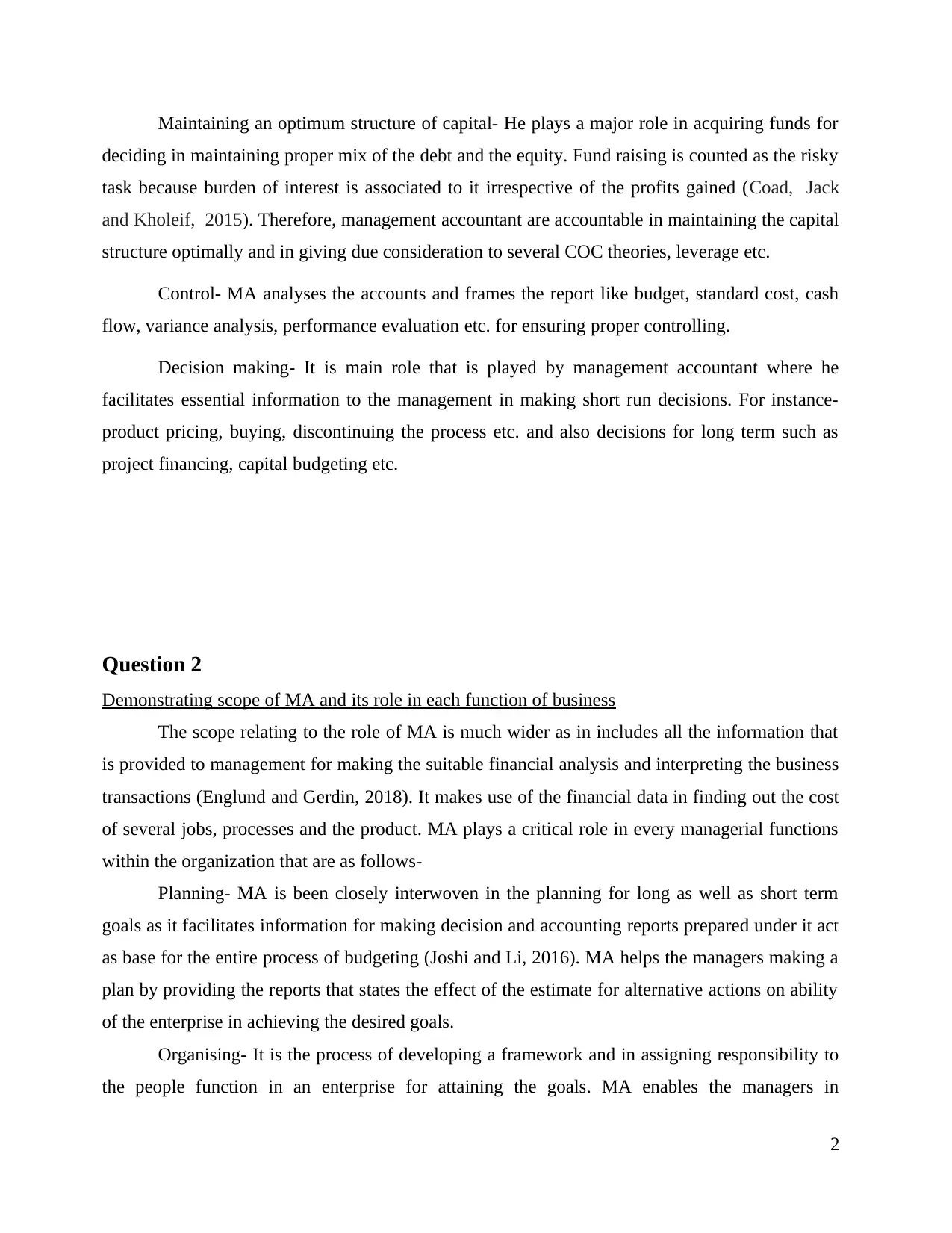
Maintaining an optimum structure of capital- He plays a major role in acquiring funds for
deciding in maintaining proper mix of the debt and the equity. Fund raising is counted as the risky
task because burden of interest is associated to it irrespective of the profits gained (Coad, Jack
and Kholeif, 2015). Therefore, management accountant are accountable in maintaining the capital
structure optimally and in giving due consideration to several COC theories, leverage etc.
Control- MA analyses the accounts and frames the report like budget, standard cost, cash
flow, variance analysis, performance evaluation etc. for ensuring proper controlling.
Decision making- It is main role that is played by management accountant where he
facilitates essential information to the management in making short run decisions. For instance-
product pricing, buying, discontinuing the process etc. and also decisions for long term such as
project financing, capital budgeting etc.
Question 2
Demonstrating scope of MA and its role in each function of business
The scope relating to the role of MA is much wider as in includes all the information that
is provided to management for making the suitable financial analysis and interpreting the business
transactions (Englund and Gerdin, 2018). It makes use of the financial data in finding out the cost
of several jobs, processes and the product. MA plays a critical role in every managerial functions
within the organization that are as follows-
Planning- MA is been closely interwoven in the planning for long as well as short term
goals as it facilitates information for making decision and accounting reports prepared under it act
as base for the entire process of budgeting (Joshi and Li, 2016). MA helps the managers making a
plan by providing the reports that states the effect of the estimate for alternative actions on ability
of the enterprise in achieving the desired goals.
Organising- It is the process of developing a framework and in assigning responsibility to
the people function in an enterprise for attaining the goals. MA enables the managers in
2
deciding in maintaining proper mix of the debt and the equity. Fund raising is counted as the risky
task because burden of interest is associated to it irrespective of the profits gained (Coad, Jack
and Kholeif, 2015). Therefore, management accountant are accountable in maintaining the capital
structure optimally and in giving due consideration to several COC theories, leverage etc.
Control- MA analyses the accounts and frames the report like budget, standard cost, cash
flow, variance analysis, performance evaluation etc. for ensuring proper controlling.
Decision making- It is main role that is played by management accountant where he
facilitates essential information to the management in making short run decisions. For instance-
product pricing, buying, discontinuing the process etc. and also decisions for long term such as
project financing, capital budgeting etc.
Question 2
Demonstrating scope of MA and its role in each function of business
The scope relating to the role of MA is much wider as in includes all the information that
is provided to management for making the suitable financial analysis and interpreting the business
transactions (Englund and Gerdin, 2018). It makes use of the financial data in finding out the cost
of several jobs, processes and the product. MA plays a critical role in every managerial functions
within the organization that are as follows-
Planning- MA is been closely interwoven in the planning for long as well as short term
goals as it facilitates information for making decision and accounting reports prepared under it act
as base for the entire process of budgeting (Joshi and Li, 2016). MA helps the managers making a
plan by providing the reports that states the effect of the estimate for alternative actions on ability
of the enterprise in achieving the desired goals.
Organising- It is the process of developing a framework and in assigning responsibility to
the people function in an enterprise for attaining the goals. MA enables the managers in
2
Paraphrase This Document
Need a fresh take? Get an instant paraphrase of this document with our AI Paraphraser
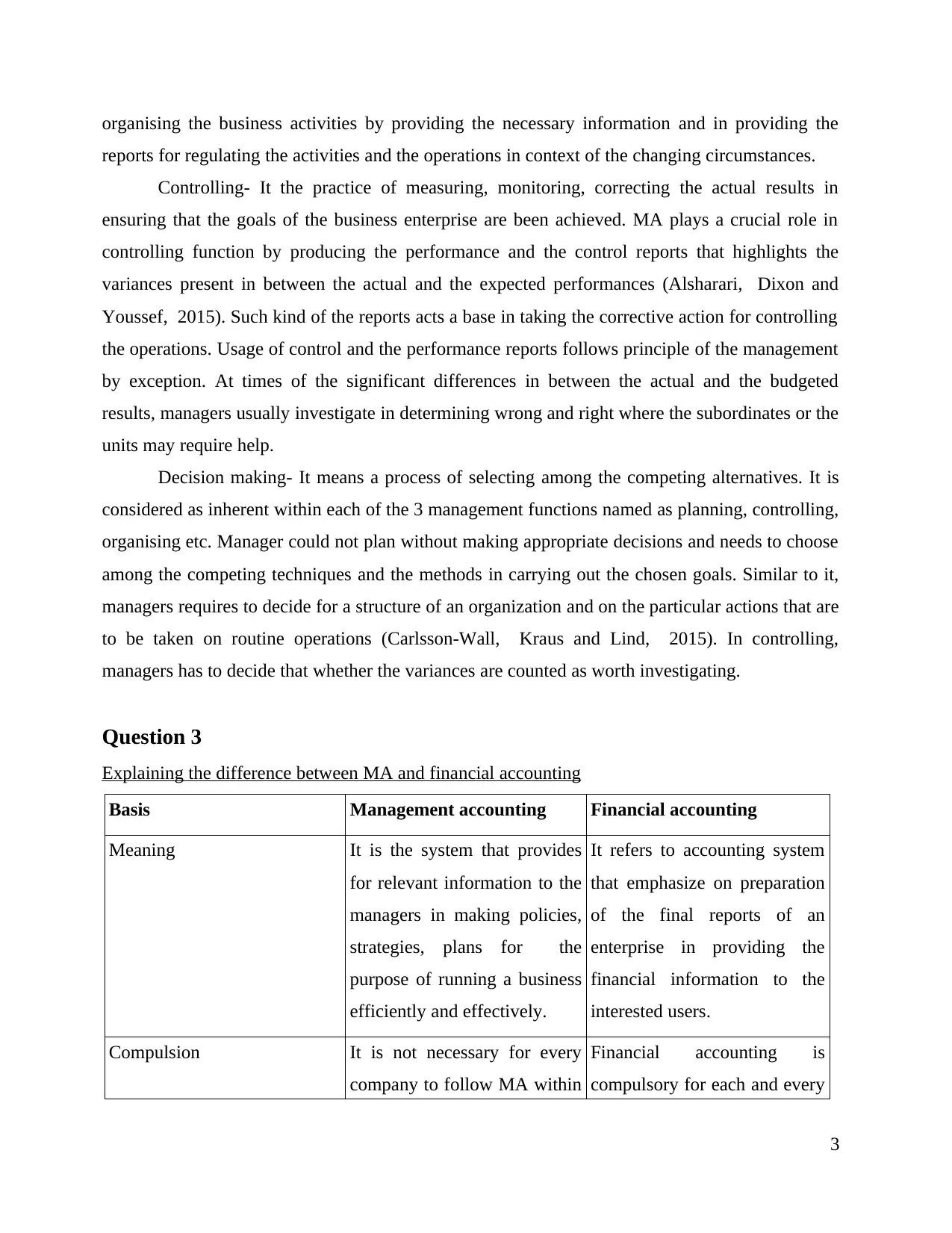
organising the business activities by providing the necessary information and in providing the
reports for regulating the activities and the operations in context of the changing circumstances.
Controlling- It the practice of measuring, monitoring, correcting the actual results in
ensuring that the goals of the business enterprise are been achieved. MA plays a crucial role in
controlling function by producing the performance and the control reports that highlights the
variances present in between the actual and the expected performances (Alsharari, Dixon and
Youssef, 2015). Such kind of the reports acts a base in taking the corrective action for controlling
the operations. Usage of control and the performance reports follows principle of the management
by exception. At times of the significant differences in between the actual and the budgeted
results, managers usually investigate in determining wrong and right where the subordinates or the
units may require help.
Decision making- It means a process of selecting among the competing alternatives. It is
considered as inherent within each of the 3 management functions named as planning, controlling,
organising etc. Manager could not plan without making appropriate decisions and needs to choose
among the competing techniques and the methods in carrying out the chosen goals. Similar to it,
managers requires to decide for a structure of an organization and on the particular actions that are
to be taken on routine operations (Carlsson-Wall, Kraus and Lind, 2015). In controlling,
managers has to decide that whether the variances are counted as worth investigating.
Question 3
Explaining the difference between MA and financial accounting
Basis Management accounting Financial accounting
Meaning It is the system that provides
for relevant information to the
managers in making policies,
strategies, plans for the
purpose of running a business
efficiently and effectively.
It refers to accounting system
that emphasize on preparation
of the final reports of an
enterprise in providing the
financial information to the
interested users.
Compulsion It is not necessary for every
company to follow MA within
Financial accounting is
compulsory for each and every
3
reports for regulating the activities and the operations in context of the changing circumstances.
Controlling- It the practice of measuring, monitoring, correcting the actual results in
ensuring that the goals of the business enterprise are been achieved. MA plays a crucial role in
controlling function by producing the performance and the control reports that highlights the
variances present in between the actual and the expected performances (Alsharari, Dixon and
Youssef, 2015). Such kind of the reports acts a base in taking the corrective action for controlling
the operations. Usage of control and the performance reports follows principle of the management
by exception. At times of the significant differences in between the actual and the budgeted
results, managers usually investigate in determining wrong and right where the subordinates or the
units may require help.
Decision making- It means a process of selecting among the competing alternatives. It is
considered as inherent within each of the 3 management functions named as planning, controlling,
organising etc. Manager could not plan without making appropriate decisions and needs to choose
among the competing techniques and the methods in carrying out the chosen goals. Similar to it,
managers requires to decide for a structure of an organization and on the particular actions that are
to be taken on routine operations (Carlsson-Wall, Kraus and Lind, 2015). In controlling,
managers has to decide that whether the variances are counted as worth investigating.
Question 3
Explaining the difference between MA and financial accounting
Basis Management accounting Financial accounting
Meaning It is the system that provides
for relevant information to the
managers in making policies,
strategies, plans for the
purpose of running a business
efficiently and effectively.
It refers to accounting system
that emphasize on preparation
of the final reports of an
enterprise in providing the
financial information to the
interested users.
Compulsion It is not necessary for every
company to follow MA within
Financial accounting is
compulsory for each and every
3
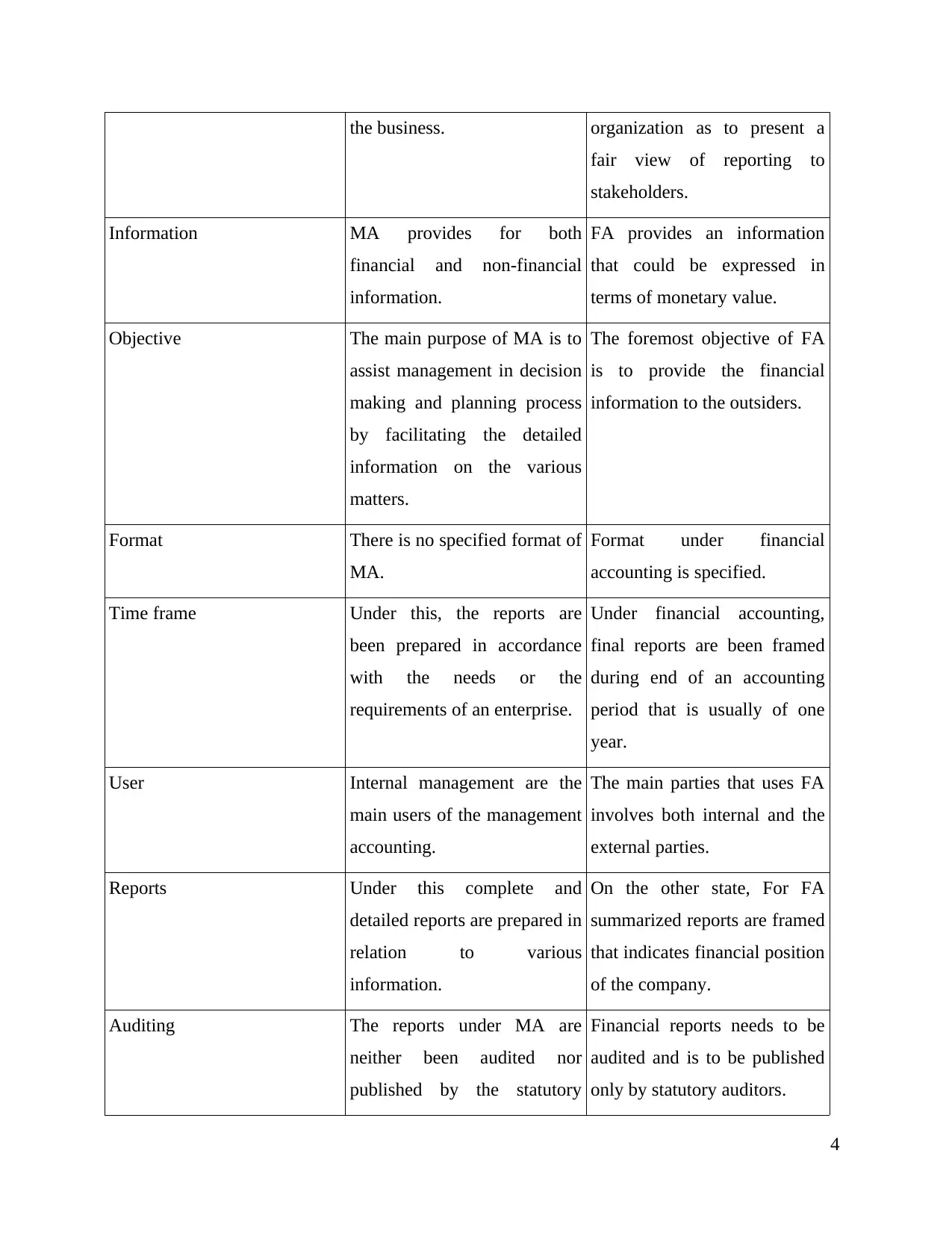
the business. organization as to present a
fair view of reporting to
stakeholders.
Information MA provides for both
financial and non-financial
information.
FA provides an information
that could be expressed in
terms of monetary value.
Objective The main purpose of MA is to
assist management in decision
making and planning process
by facilitating the detailed
information on the various
matters.
The foremost objective of FA
is to provide the financial
information to the outsiders.
Format There is no specified format of
MA.
Format under financial
accounting is specified.
Time frame Under this, the reports are
been prepared in accordance
with the needs or the
requirements of an enterprise.
Under financial accounting,
final reports are been framed
during end of an accounting
period that is usually of one
year.
User Internal management are the
main users of the management
accounting.
The main parties that uses FA
involves both internal and the
external parties.
Reports Under this complete and
detailed reports are prepared in
relation to various
information.
On the other state, For FA
summarized reports are framed
that indicates financial position
of the company.
Auditing The reports under MA are
neither been audited nor
published by the statutory
Financial reports needs to be
audited and is to be published
only by statutory auditors.
4
fair view of reporting to
stakeholders.
Information MA provides for both
financial and non-financial
information.
FA provides an information
that could be expressed in
terms of monetary value.
Objective The main purpose of MA is to
assist management in decision
making and planning process
by facilitating the detailed
information on the various
matters.
The foremost objective of FA
is to provide the financial
information to the outsiders.
Format There is no specified format of
MA.
Format under financial
accounting is specified.
Time frame Under this, the reports are
been prepared in accordance
with the needs or the
requirements of an enterprise.
Under financial accounting,
final reports are been framed
during end of an accounting
period that is usually of one
year.
User Internal management are the
main users of the management
accounting.
The main parties that uses FA
involves both internal and the
external parties.
Reports Under this complete and
detailed reports are prepared in
relation to various
information.
On the other state, For FA
summarized reports are framed
that indicates financial position
of the company.
Auditing The reports under MA are
neither been audited nor
published by the statutory
Financial reports needs to be
audited and is to be published
only by statutory auditors.
4
⊘ This is a preview!⊘
Do you want full access?
Subscribe today to unlock all pages.

Trusted by 1+ million students worldwide
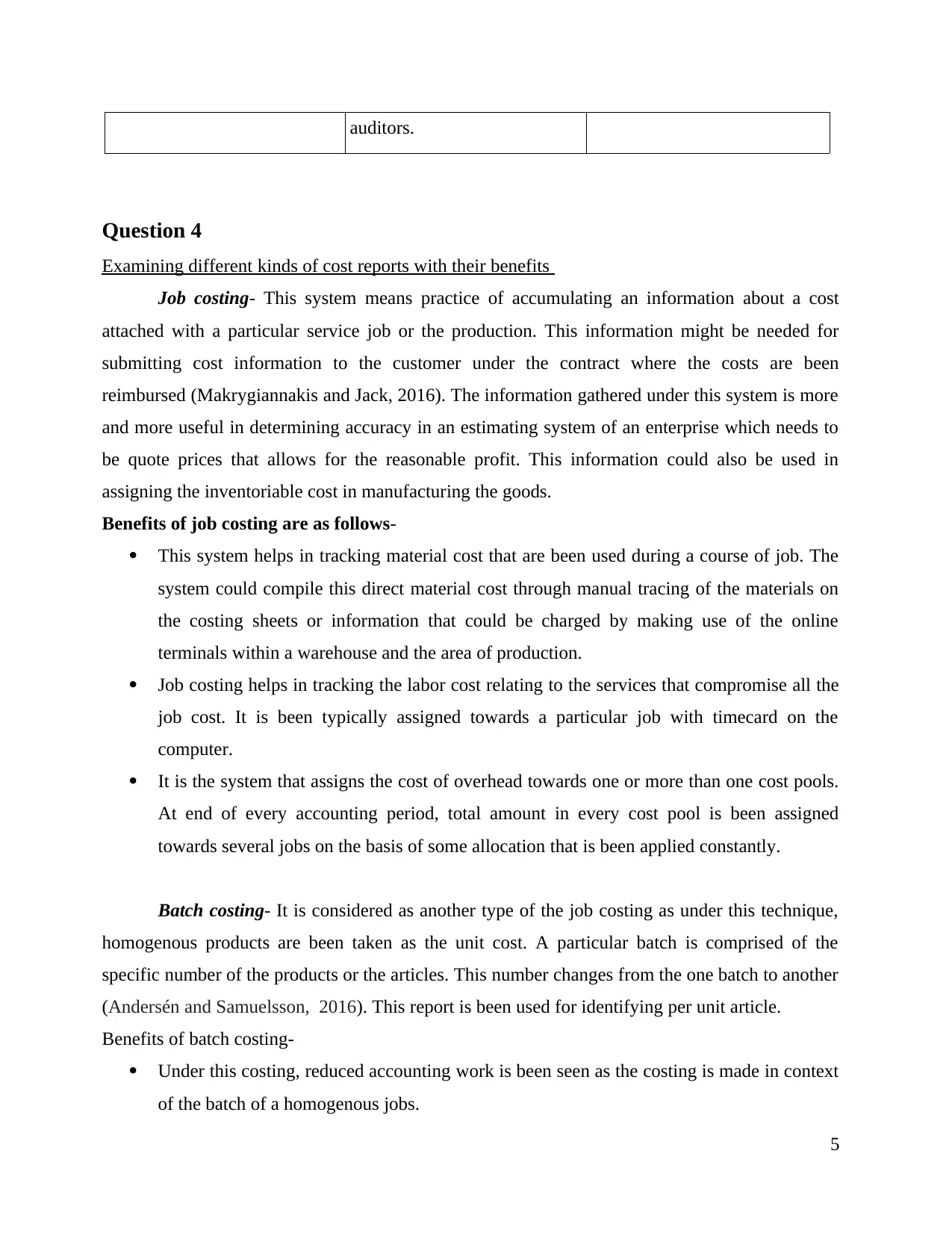
auditors.
Question 4
Examining different kinds of cost reports with their benefits
Job costing- This system means practice of accumulating an information about a cost
attached with a particular service job or the production. This information might be needed for
submitting cost information to the customer under the contract where the costs are been
reimbursed (Makrygiannakis and Jack, 2016). The information gathered under this system is more
and more useful in determining accuracy in an estimating system of an enterprise which needs to
be quote prices that allows for the reasonable profit. This information could also be used in
assigning the inventoriable cost in manufacturing the goods.
Benefits of job costing are as follows-
This system helps in tracking material cost that are been used during a course of job. The
system could compile this direct material cost through manual tracing of the materials on
the costing sheets or information that could be charged by making use of the online
terminals within a warehouse and the area of production.
Job costing helps in tracking the labor cost relating to the services that compromise all the
job cost. It is been typically assigned towards a particular job with timecard on the
computer.
It is the system that assigns the cost of overhead towards one or more than one cost pools.
At end of every accounting period, total amount in every cost pool is been assigned
towards several jobs on the basis of some allocation that is been applied constantly.
Batch costing- It is considered as another type of the job costing as under this technique,
homogenous products are been taken as the unit cost. A particular batch is comprised of the
specific number of the products or the articles. This number changes from the one batch to another
(Andersén and Samuelsson, 2016). This report is been used for identifying per unit article.
Benefits of batch costing-
Under this costing, reduced accounting work is been seen as the costing is made in context
of the batch of a homogenous jobs.
5
Question 4
Examining different kinds of cost reports with their benefits
Job costing- This system means practice of accumulating an information about a cost
attached with a particular service job or the production. This information might be needed for
submitting cost information to the customer under the contract where the costs are been
reimbursed (Makrygiannakis and Jack, 2016). The information gathered under this system is more
and more useful in determining accuracy in an estimating system of an enterprise which needs to
be quote prices that allows for the reasonable profit. This information could also be used in
assigning the inventoriable cost in manufacturing the goods.
Benefits of job costing are as follows-
This system helps in tracking material cost that are been used during a course of job. The
system could compile this direct material cost through manual tracing of the materials on
the costing sheets or information that could be charged by making use of the online
terminals within a warehouse and the area of production.
Job costing helps in tracking the labor cost relating to the services that compromise all the
job cost. It is been typically assigned towards a particular job with timecard on the
computer.
It is the system that assigns the cost of overhead towards one or more than one cost pools.
At end of every accounting period, total amount in every cost pool is been assigned
towards several jobs on the basis of some allocation that is been applied constantly.
Batch costing- It is considered as another type of the job costing as under this technique,
homogenous products are been taken as the unit cost. A particular batch is comprised of the
specific number of the products or the articles. This number changes from the one batch to another
(Andersén and Samuelsson, 2016). This report is been used for identifying per unit article.
Benefits of batch costing-
Under this costing, reduced accounting work is been seen as the costing is made in context
of the batch of a homogenous jobs.
5
Paraphrase This Document
Need a fresh take? Get an instant paraphrase of this document with our AI Paraphraser
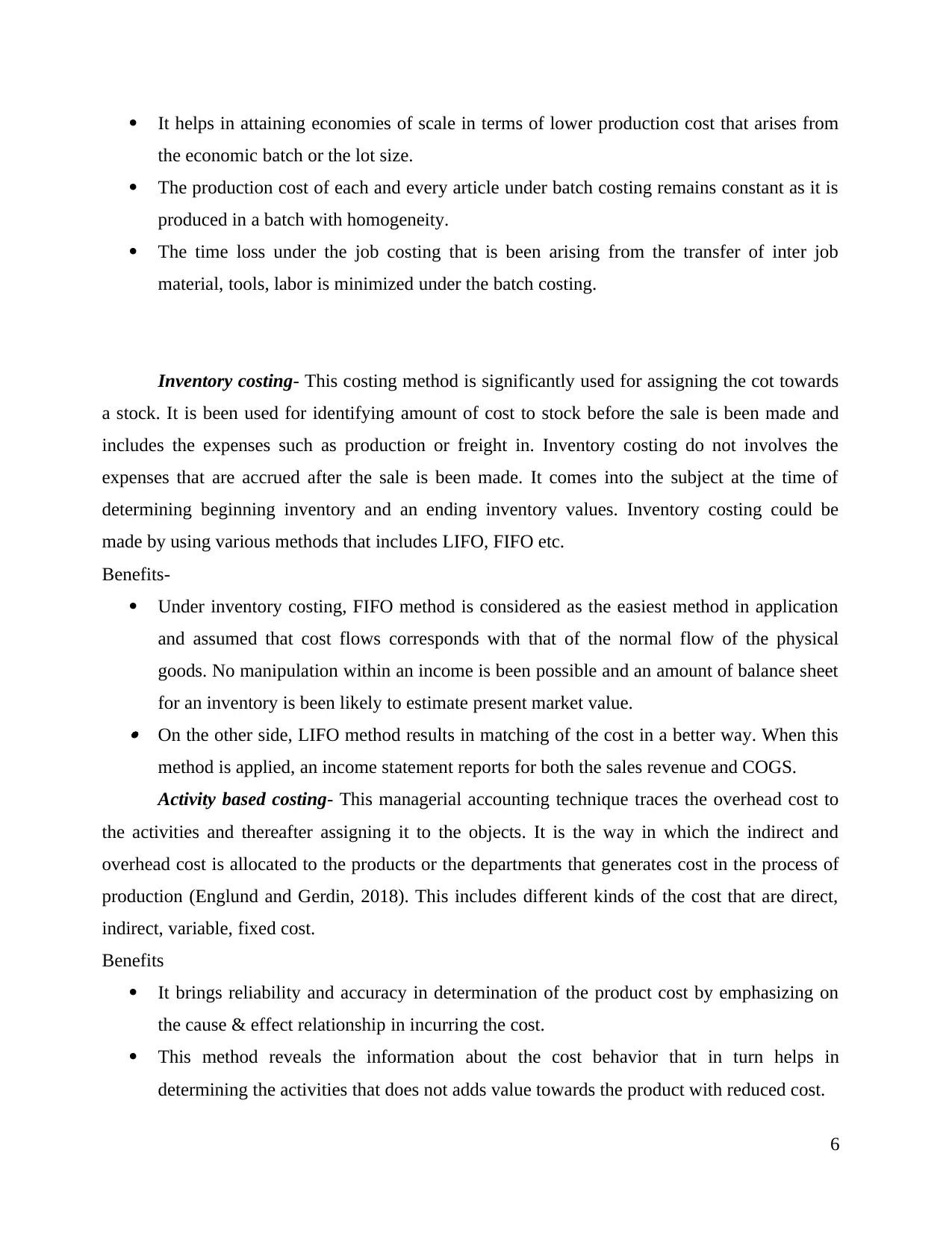
It helps in attaining economies of scale in terms of lower production cost that arises from
the economic batch or the lot size.
The production cost of each and every article under batch costing remains constant as it is
produced in a batch with homogeneity.
The time loss under the job costing that is been arising from the transfer of inter job
material, tools, labor is minimized under the batch costing.
Inventory costing- This costing method is significantly used for assigning the cot towards
a stock. It is been used for identifying amount of cost to stock before the sale is been made and
includes the expenses such as production or freight in. Inventory costing do not involves the
expenses that are accrued after the sale is been made. It comes into the subject at the time of
determining beginning inventory and an ending inventory values. Inventory costing could be
made by using various methods that includes LIFO, FIFO etc.
Benefits-
Under inventory costing, FIFO method is considered as the easiest method in application
and assumed that cost flows corresponds with that of the normal flow of the physical
goods. No manipulation within an income is been possible and an amount of balance sheet
for an inventory is been likely to estimate present market value. On the other side, LIFO method results in matching of the cost in a better way. When this
method is applied, an income statement reports for both the sales revenue and COGS.
Activity based costing- This managerial accounting technique traces the overhead cost to
the activities and thereafter assigning it to the objects. It is the way in which the indirect and
overhead cost is allocated to the products or the departments that generates cost in the process of
production (Englund and Gerdin, 2018). This includes different kinds of the cost that are direct,
indirect, variable, fixed cost.
Benefits
It brings reliability and accuracy in determination of the product cost by emphasizing on
the cause & effect relationship in incurring the cost.
This method reveals the information about the cost behavior that in turn helps in
determining the activities that does not adds value towards the product with reduced cost.
6
the economic batch or the lot size.
The production cost of each and every article under batch costing remains constant as it is
produced in a batch with homogeneity.
The time loss under the job costing that is been arising from the transfer of inter job
material, tools, labor is minimized under the batch costing.
Inventory costing- This costing method is significantly used for assigning the cot towards
a stock. It is been used for identifying amount of cost to stock before the sale is been made and
includes the expenses such as production or freight in. Inventory costing do not involves the
expenses that are accrued after the sale is been made. It comes into the subject at the time of
determining beginning inventory and an ending inventory values. Inventory costing could be
made by using various methods that includes LIFO, FIFO etc.
Benefits-
Under inventory costing, FIFO method is considered as the easiest method in application
and assumed that cost flows corresponds with that of the normal flow of the physical
goods. No manipulation within an income is been possible and an amount of balance sheet
for an inventory is been likely to estimate present market value. On the other side, LIFO method results in matching of the cost in a better way. When this
method is applied, an income statement reports for both the sales revenue and COGS.
Activity based costing- This managerial accounting technique traces the overhead cost to
the activities and thereafter assigning it to the objects. It is the way in which the indirect and
overhead cost is allocated to the products or the departments that generates cost in the process of
production (Englund and Gerdin, 2018). This includes different kinds of the cost that are direct,
indirect, variable, fixed cost.
Benefits
It brings reliability and accuracy in determination of the product cost by emphasizing on
the cause & effect relationship in incurring the cost.
This method reveals the information about the cost behavior that in turn helps in
determining the activities that does not adds value towards the product with reduced cost.
6
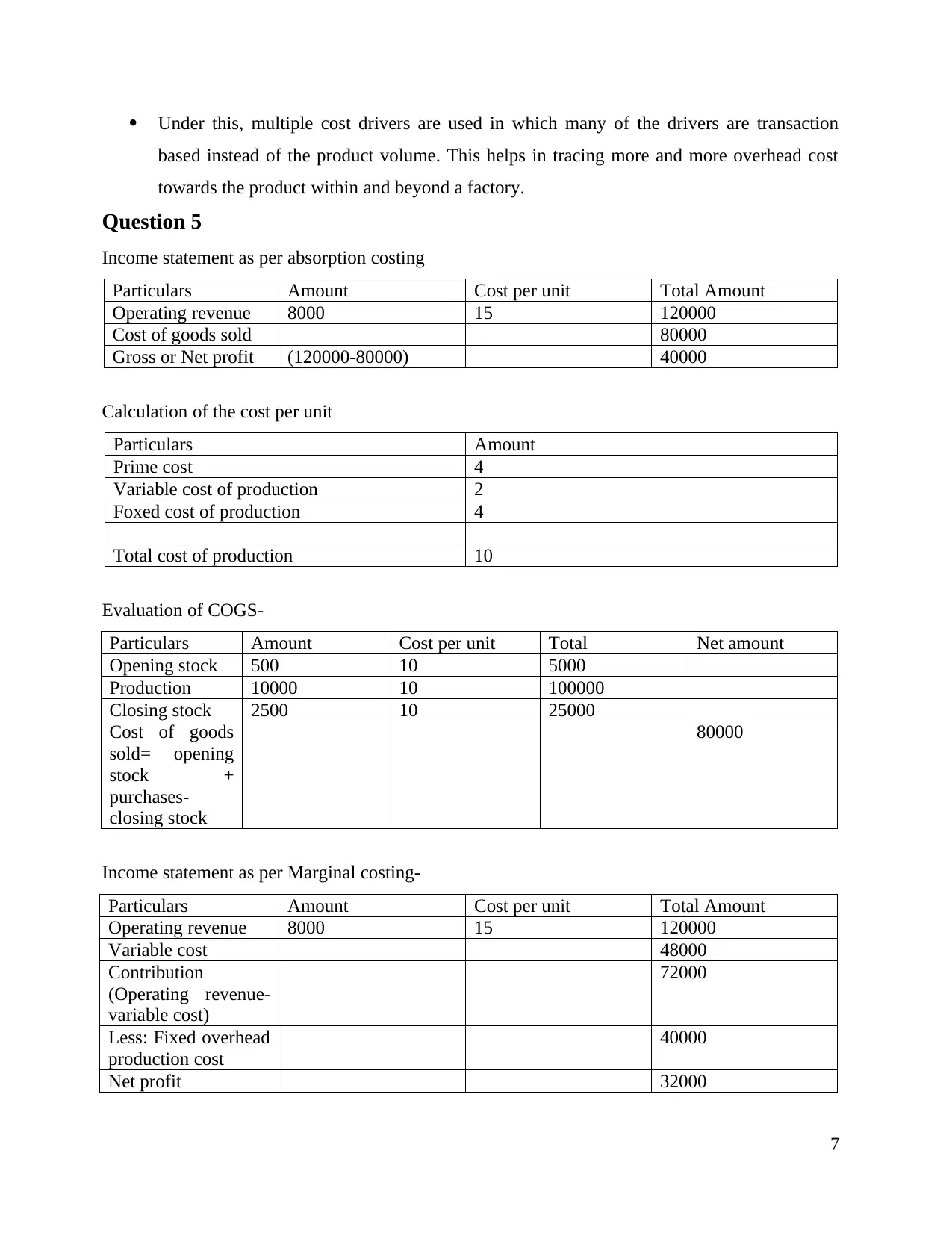
Under this, multiple cost drivers are used in which many of the drivers are transaction
based instead of the product volume. This helps in tracing more and more overhead cost
towards the product within and beyond a factory.
Question 5
Income statement as per absorption costing
Particulars Amount Cost per unit Total Amount
Operating revenue 8000 15 120000
Cost of goods sold 80000
Gross or Net profit (120000-80000) 40000
Calculation of the cost per unit
Particulars Amount
Prime cost 4
Variable cost of production 2
Foxed cost of production 4
Total cost of production 10
Evaluation of COGS-
Particulars Amount Cost per unit Total Net amount
Opening stock 500 10 5000
Production 10000 10 100000
Closing stock 2500 10 25000
Cost of goods
sold= opening
stock +
purchases-
closing stock
80000
Income statement as per Marginal costing-
Particulars Amount Cost per unit Total Amount
Operating revenue 8000 15 120000
Variable cost 48000
Contribution
(Operating revenue-
variable cost)
72000
Less: Fixed overhead
production cost
40000
Net profit 32000
7
based instead of the product volume. This helps in tracing more and more overhead cost
towards the product within and beyond a factory.
Question 5
Income statement as per absorption costing
Particulars Amount Cost per unit Total Amount
Operating revenue 8000 15 120000
Cost of goods sold 80000
Gross or Net profit (120000-80000) 40000
Calculation of the cost per unit
Particulars Amount
Prime cost 4
Variable cost of production 2
Foxed cost of production 4
Total cost of production 10
Evaluation of COGS-
Particulars Amount Cost per unit Total Net amount
Opening stock 500 10 5000
Production 10000 10 100000
Closing stock 2500 10 25000
Cost of goods
sold= opening
stock +
purchases-
closing stock
80000
Income statement as per Marginal costing-
Particulars Amount Cost per unit Total Amount
Operating revenue 8000 15 120000
Variable cost 48000
Contribution
(Operating revenue-
variable cost)
72000
Less: Fixed overhead
production cost
40000
Net profit 32000
7
⊘ This is a preview!⊘
Do you want full access?
Subscribe today to unlock all pages.

Trusted by 1+ million students worldwide
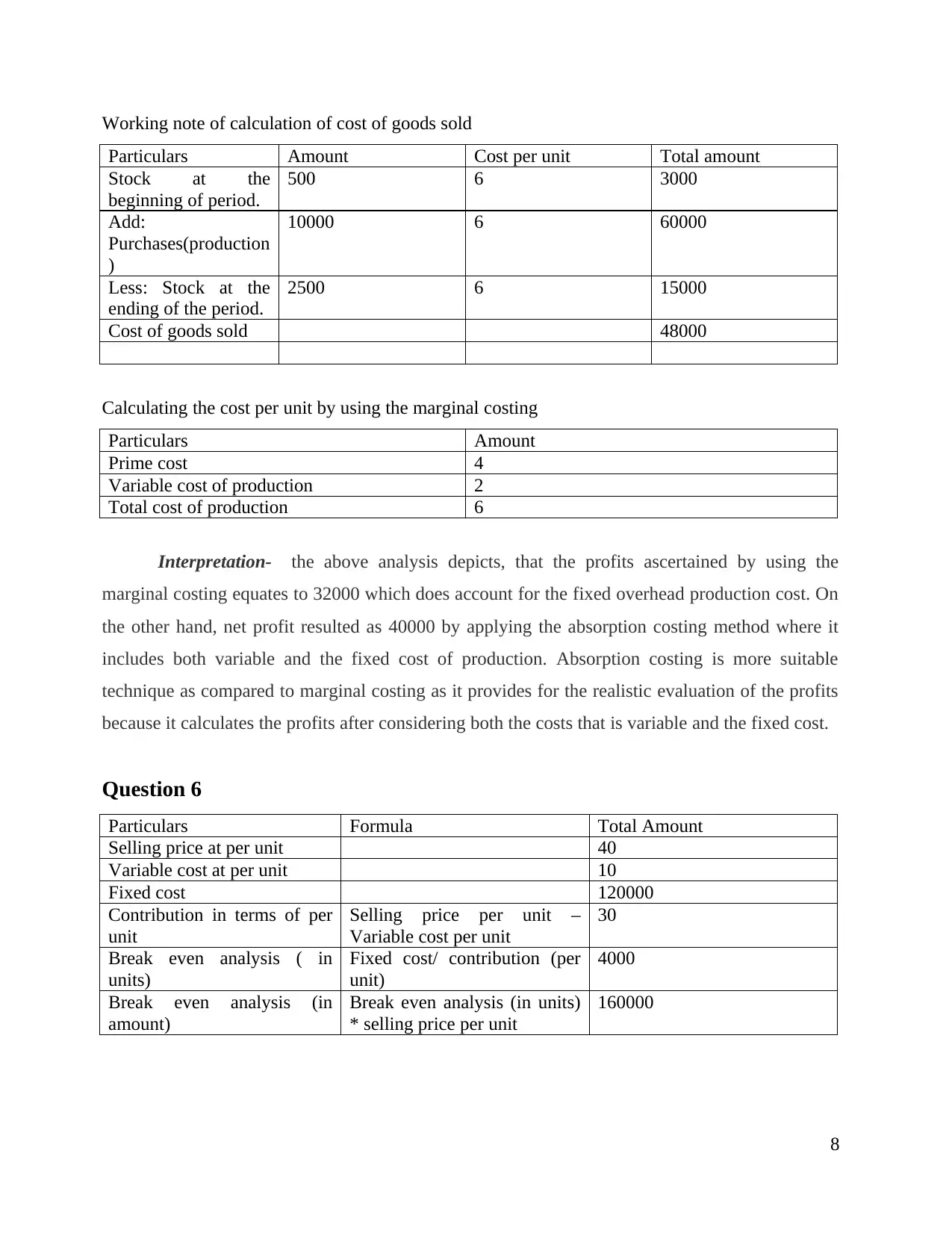
Working note of calculation of cost of goods sold
Particulars Amount Cost per unit Total amount
Stock at the
beginning of period.
500 6 3000
Add:
Purchases(production
)
10000 6 60000
Less: Stock at the
ending of the period.
2500 6 15000
Cost of goods sold 48000
Calculating the cost per unit by using the marginal costing
Particulars Amount
Prime cost 4
Variable cost of production 2
Total cost of production 6
Interpretation- the above analysis depicts, that the profits ascertained by using the
marginal costing equates to 32000 which does account for the fixed overhead production cost. On
the other hand, net profit resulted as 40000 by applying the absorption costing method where it
includes both variable and the fixed cost of production. Absorption costing is more suitable
technique as compared to marginal costing as it provides for the realistic evaluation of the profits
because it calculates the profits after considering both the costs that is variable and the fixed cost.
Question 6
Particulars Formula Total Amount
Selling price at per unit 40
Variable cost at per unit 10
Fixed cost 120000
Contribution in terms of per
unit
Selling price per unit –
Variable cost per unit
30
Break even analysis ( in
units)
Fixed cost/ contribution (per
unit)
4000
Break even analysis (in
amount)
Break even analysis (in units)
* selling price per unit
160000
8
Particulars Amount Cost per unit Total amount
Stock at the
beginning of period.
500 6 3000
Add:
Purchases(production
)
10000 6 60000
Less: Stock at the
ending of the period.
2500 6 15000
Cost of goods sold 48000
Calculating the cost per unit by using the marginal costing
Particulars Amount
Prime cost 4
Variable cost of production 2
Total cost of production 6
Interpretation- the above analysis depicts, that the profits ascertained by using the
marginal costing equates to 32000 which does account for the fixed overhead production cost. On
the other hand, net profit resulted as 40000 by applying the absorption costing method where it
includes both variable and the fixed cost of production. Absorption costing is more suitable
technique as compared to marginal costing as it provides for the realistic evaluation of the profits
because it calculates the profits after considering both the costs that is variable and the fixed cost.
Question 6
Particulars Formula Total Amount
Selling price at per unit 40
Variable cost at per unit 10
Fixed cost 120000
Contribution in terms of per
unit
Selling price per unit –
Variable cost per unit
30
Break even analysis ( in
units)
Fixed cost/ contribution (per
unit)
4000
Break even analysis (in
amount)
Break even analysis (in units)
* selling price per unit
160000
8
Paraphrase This Document
Need a fresh take? Get an instant paraphrase of this document with our AI Paraphraser
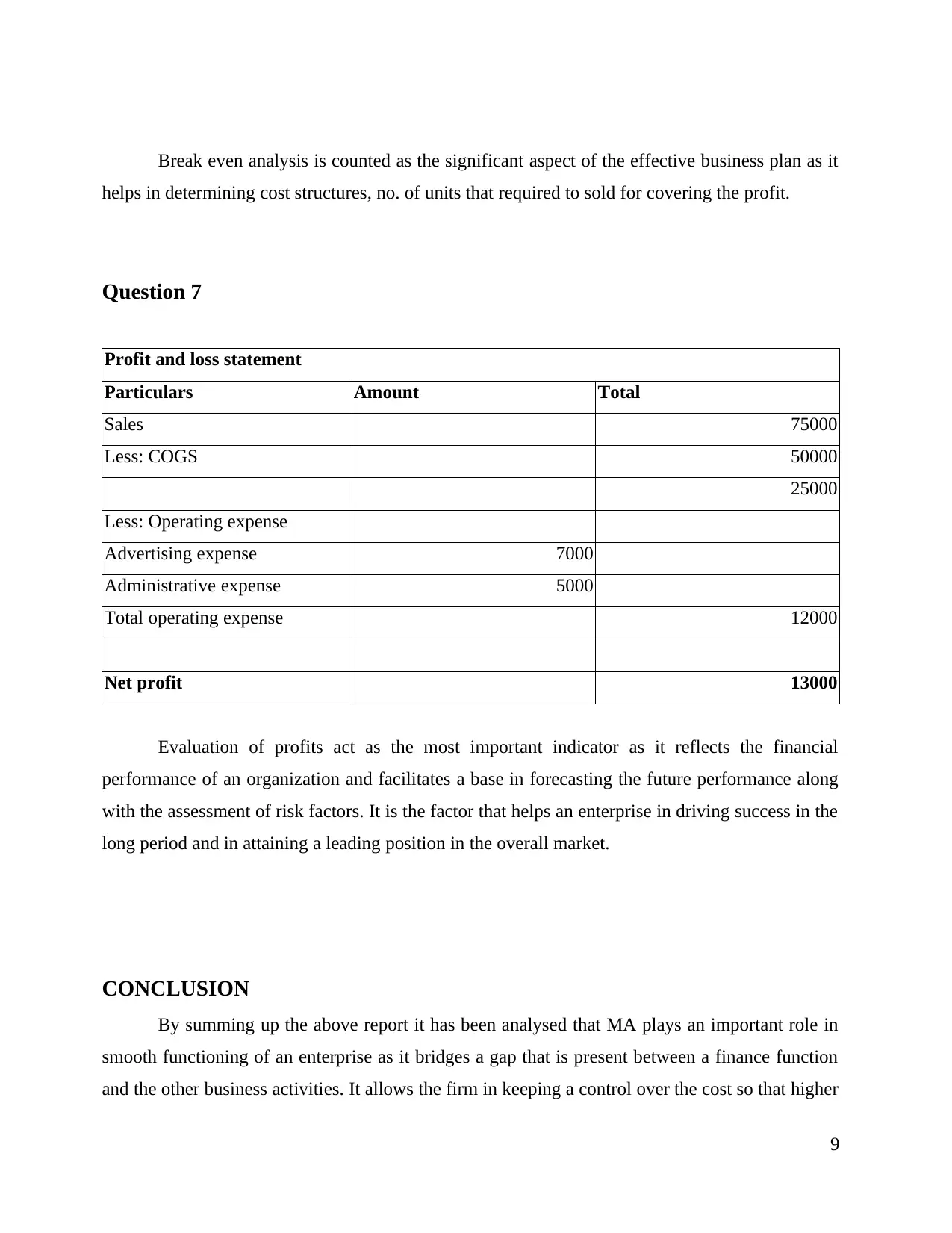
Break even analysis is counted as the significant aspect of the effective business plan as it
helps in determining cost structures, no. of units that required to sold for covering the profit.
Question 7
Profit and loss statement
Particulars Amount Total
Sales 75000
Less: COGS 50000
25000
Less: Operating expense
Advertising expense 7000
Administrative expense 5000
Total operating expense 12000
Net profit 13000
Evaluation of profits act as the most important indicator as it reflects the financial
performance of an organization and facilitates a base in forecasting the future performance along
with the assessment of risk factors. It is the factor that helps an enterprise in driving success in the
long period and in attaining a leading position in the overall market.
CONCLUSION
By summing up the above report it has been analysed that MA plays an important role in
smooth functioning of an enterprise as it bridges a gap that is present between a finance function
and the other business activities. It allows the firm in keeping a control over the cost so that higher
9
helps in determining cost structures, no. of units that required to sold for covering the profit.
Question 7
Profit and loss statement
Particulars Amount Total
Sales 75000
Less: COGS 50000
25000
Less: Operating expense
Advertising expense 7000
Administrative expense 5000
Total operating expense 12000
Net profit 13000
Evaluation of profits act as the most important indicator as it reflects the financial
performance of an organization and facilitates a base in forecasting the future performance along
with the assessment of risk factors. It is the factor that helps an enterprise in driving success in the
long period and in attaining a leading position in the overall market.
CONCLUSION
By summing up the above report it has been analysed that MA plays an important role in
smooth functioning of an enterprise as it bridges a gap that is present between a finance function
and the other business activities. It allows the firm in keeping a control over the cost so that higher
9
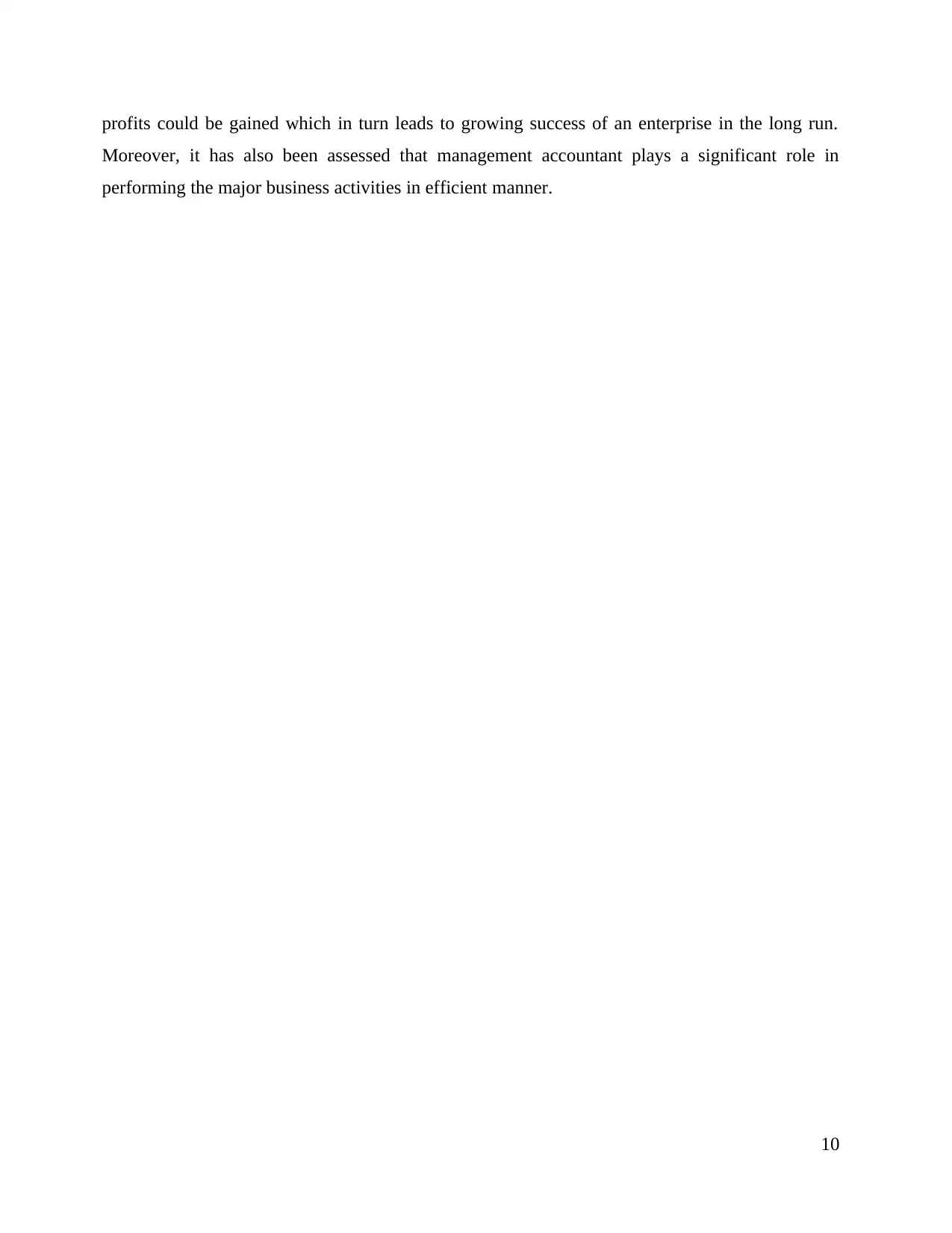
profits could be gained which in turn leads to growing success of an enterprise in the long run.
Moreover, it has also been assessed that management accountant plays a significant role in
performing the major business activities in efficient manner.
10
Moreover, it has also been assessed that management accountant plays a significant role in
performing the major business activities in efficient manner.
10
⊘ This is a preview!⊘
Do you want full access?
Subscribe today to unlock all pages.

Trusted by 1+ million students worldwide
1 out of 13
Related Documents
Your All-in-One AI-Powered Toolkit for Academic Success.
+13062052269
info@desklib.com
Available 24*7 on WhatsApp / Email
![[object Object]](/_next/static/media/star-bottom.7253800d.svg)
Unlock your academic potential
Copyright © 2020–2025 A2Z Services. All Rights Reserved. Developed and managed by ZUCOL.





